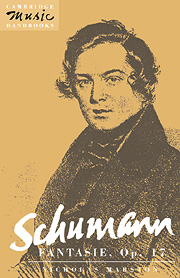Book contents
- Frontmatter
- Contents
- List of plates
- Preface
- Acknowledgements
- List of abbreviations
- 1 The compositional history of the Fantasie
- 2 ‘What's in a name?’ Genre and title in the Fantasie
- 3 Allusion and quotation in the Fantasie
- 4 Form in the first movement
- 5 Schlegel's leiser Ton and thematic unity in the Fantasie
- 6 Form in the second and third movements
- 7 The subsequent history of the Fantasie
- Notes
- Bibliography
- Index
- Plate section
4 - Form in the first movement
Published online by Cambridge University Press: 26 January 2010
- Frontmatter
- Contents
- List of plates
- Preface
- Acknowledgements
- List of abbreviations
- 1 The compositional history of the Fantasie
- 2 ‘What's in a name?’ Genre and title in the Fantasie
- 3 Allusion and quotation in the Fantasie
- 4 Form in the first movement
- 5 Schlegel's leiser Ton and thematic unity in the Fantasie
- 6 Form in the second and third movements
- 7 The subsequent history of the Fantasie
- Notes
- Bibliography
- Index
- Plate section
Summary
Form and sonata form
To speak of such a movement as a sonata form with irregularities is like calling a dog irregular when it grows long whiskers, washes its face, and miaows.
Viewed individually – their sequence is obviously unconventional – all three movements appear at first to be somewhat akin to sonata form; only upon closer acquaintance does one realize that a characteristic element in the Fantasie is precisely the free mixture of different art forms.
As regards form, the mistake comes in wanting to claim that the [first movement] is in any single form.
The first of these three statements wryly anticipates one of the main conclusions reached below. And to juxtapose the other two, published in 1858 and 1984 respectively, is in a sense to summarize the history of attempts to analyse the first movement of the Fantasie while demonstrating how circular that history has been. The first movement has always been recognized as the most distinguished of the three. This tradition stems from Schumann himself, who described the movement to Clara as the most passionate piece he had ever written. As for the issue of form, analysts have been much exercised by the relationship to the whole of the Im Legendenton section. To the extent that this separately titled section is in a different key, metre and tempo to the rest of the movement, it appears to form an independent interlude; but closer study reveals that it grows out of the preceding music.
- Type
- Chapter
- Information
- Schumann: Fantasie, Op. 17 , pp. 43 - 60Publisher: Cambridge University PressPrint publication year: 1992



